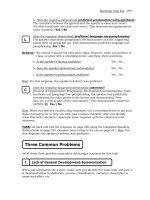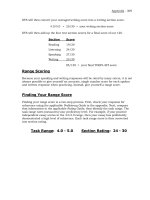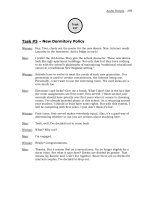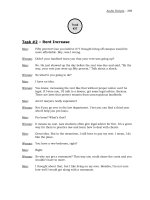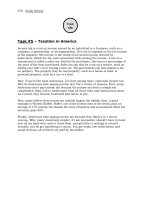Tài liệu Speaking and Writing Strategies for the TOEFL iBT part 28 doc
Bạn đang xem bản rút gọn của tài liệu. Xem và tải ngay bản đầy đủ của tài liệu tại đây (292.01 KB, 10 trang )
Speaking Task Four - 259
Directions: Read the passage about Charles Darwin. You have 45 seconds.
Next, listen to a lecture in a biology class.
After you listen to the lecture, answer the prompt.
TASK: You have 30 seconds to prepare your response and 60 seconds to speak.
Charles Darwin
Charles Darwin is famous for his groundbreaking book On the Origin of
Species published in 1851. In it, Darwin theorized that all organisms
evolved through natural selection. Natural selection, as defined by Darwin,
is the process in which an organism inherits traits that make it more likely
to survive and successfully reproduce, and thus become more common.
Darwin had witnessed this same process of selection in farmers breeding
domestic livestock. By selective breeding, farmers could produce the results
they were after, such as a cow that produced more milk or a sheep that
produced more wool. Darwin analogized by observation that this same
process of selection was naturally occurring in all organisms in the wild.
However, it was the hand of nature, not the hand of man, that was doing
the selecting. Darwin’s theory revolutionized scientific thought, for
according to Darwin, natural selection proved that divine creation played no
part in the creation and evolution of organisms.
Prompt Summarize the points made in the lecture and show how they add
to and support the information in the reading.
Task #3
CD
Track
#21
260 - Speaking Task Four r
Directions: Read the passage about white collar crime. You have 45 seconds.
Next, listen to a lecture in a sociology class.
After you listen to the lecture, answer the prompt.
TASK: You have 30 seconds to prepare your response and 60 seconds to speak.
White Collar Crime
Most of us have never heard of Professor Edwin Sutherland yet we’ve all
heard the phrase “white collar crime.” This phrase was first coined by
Sutherland in 1939 when he gave a presentation to the American
Sociological Society. Sutherland had been studying two areas: crime and
high society, specifically rich men who wore suits with ties and white shirts,
hence the white collar analogy. Sutherland came to define white collar crime
as a "crime committed by a person of respectability and high social status in
the course of his occupation." In other words, a white collar criminal could
be a bank manager stealing money from his bank or a stockbroker giving
false tips to inflate the price of a failing stock.
Prompt The reading and the lecture focus on white collar crime. Describe
how the reading and the lecture define and develop this idea.
Task #4
CD
Track
#22
Speaking Task Four - 261
Directions: Read the passage about space. You have 45 seconds.
Next, listen to a lecture in an environmental class.
After you listen to the lecture, answer the prompt.
TASK: You have 30 seconds to prepare your response and 60 seconds to speak.
Prompt How do the reading and the lecture add to our understanding of
the exploration of space? Use specific examples and reasons to
explain.
Space
On October 4, 1957, the Soviet Union launched Sputnik 1, the first satellite
to orbit the earth. Thus began “the space race.” With Sputnik 1, the United
States feared that the Soviet Union would eventually develop more powerful
satellites that could spy or drop nuclear bombs on the United States. As a
result, the United States made the control of space a top priority. However,
on April 12, 1961 the Soviets once again beat America to the punch by
putting the first man into earth orbit. Ten months later, America sent its
first man into earth orbit. The space race ended when America landed men
on the moon on July 16, 1969. Today, the exploration of space continues
with the Space Shuttle making regular trips to the International Space
Station where scientists from all around the world work together developing
new technologies that might one day take us to Mars.
Task #5
CD
Track
#23
262 - Speaking Task Four r
In this chapter, you learned how to develop, revise and deliver integrated spoken
responses for speaking task four using G+3TiC=C
and the five steps. By doing so,
you can demonstrate OPDUL=C
in your response.
Test-takers who get high integrated speaking scores have practiced
speaking a lot.
What Have You Learned?
Remember!
Make a note map; summarize the reading (45 seconds).
#1
Summarize the lecture (60-90 seconds).
#2
Read the prompt.
#3
Prepare your response (30 seconds).
#4
Speak (60 seconds).
#5
Speaking Task Five - 263
For this task, you will summarize the personal-opinion argument of a student. You
will then comment about the student’s argument using your own personal-opinion
argument. By doing so, you will combine the skills of listening and speaking. The
task order follows.
For this task, you must:
take notes as you listen to the dialogue;
summarize the main points in the dialogue;
synthesize your opinion with the main points in the dialogue;
paraphrase the main points in the dialogue.
You can develop and deliver a response for this task using G+2TiC=C in
combination with G+TiC=C
. Together, G+2TiC=C and G+TiC=C will help you take
notes and give the speaking raters what they are trained to listen for: a coherent
integrated spoken response that demonstrates OPDUL=C
(see the Integrated
Speaking Proficiency Checklist, page 322).
Understanding ETS’s testing method for this task is the first step in delivering a
coherent integrated spoken response. Begin by reading along as you listen to the
sample dialogue on the next page.
Speaking Task Five
Integrated Task: Listen-Speak
Task
Time
1. Listen to a dialogue. 60-90 seconds
3. Prepare your response. 20 seconds
4. Deliver your response. 60 seconds
ETS’s Testing Method
2. Read the prompt.
264 - Speaking Task Five
In the dialogue above, notice how the woman has a problem: She was accepted by
Harvard law, but the tuition is too high for her. Notice also that the man suggests
two
solutions to the woman’s problem. This testing method is called problem-
solution.
There are always two suggested solutions to solve the problem
described in the dialogue.
Man: Hi, Betty. What’s wrong?
Woman: Well, there’s good news and bad.
Man: Okay, so what’s the good news?
Woman: I got accepted into Harvard Law.
Man: Congratulations! That’s fantastic.
Woman: Thanks. Now for the bad news: Harvard is not cheap. I nearly
died when I saw the tuition.
Man: Yeah, but it’s Harvard. Ivy League.
Woman: I know. I want to go, but I can’t afford it. I already have four
years worth of undergrad loans at this school. If I do three years
of Harvard Law, I’ll be even more in debt. I’m not sure what to
do.
Man: What about applying for a scholarship? How are your grades?
Woman: I’m at the top of my class.
Man: There you go. You’d have a really good chance of getting a
scholarship. Some scholarships pay all your tuition. If you don’t
get a full scholarship, you should at least get something for
books. I got a scholarship here, and boy did I save a bundle.
Woman: Applying for a scholarship is definitely an option. I’ll have to
check it out.
Man: You could also take time off and work for a year or two, you
know, postpone admittance. That way you could save money for
tuition. You might not be able to pay off the full cost, but you
could at least pay off some of it. That way you’d owe less in the
long run.
Woman: Yeah. Obviously, I have to make a decision.
Remember!
CD
Track
#24
Speaking Task Five - 265
Mapped out, ETS’s problem-solution testing method looks like this.
woman man
problem
no money solutions
for tuition
solution #1
try and get a scholarship to pay for the tuition
solution #2
take time off; work for money to pay for the tuition
Next, look at the prompt. Notice that this is a two-task prompt. First, you must
describe the problem
, then you must state which solution you prefer and why.
1) When you describe the problem and the solutions, summarize
them objectively using third person and the present tense (The
woman says that…The man recommends that…)
2) When you state your opinion about which solution you prefer,
speak subjectively in the present tense (I believe that…I think
that…).
When stating which solution you think is best, use your own
experience for support. This will demonstrate development-
summarization (OPD
UL=C) and topic-unity synthesis (OPDUL=C).
Topic: Harvard
solutions
Remember!
Prompt: The students discuss solutions to the woman’s
problem. Describe the problem
, then state which
solution you prefer and why.
266 - Speaking Task Five
Mapped out, you can see how you will use G+2TiC=C for your objective summary of
the problem and the two solutions, and G+TiC=C
when you subjectively state your
solution preference.
context-problem G = main topic = general
TiC = example = specific G+2TiC=C
solutions TiC = example = specific (objective)
C = conclusion = general
your position G = opinion = general
G+TiC=C
TiC = example = specific
your reason(s) (subjective)
C = conclusion = general
When developing and delivering a response for this task, use G+2TiC=C and
G+TiC=C
, and the following five steps to demonstrate OPDUL=C in your response.
First, the narrator will give instructions.
Developing a Response: Step-by-Step
Make a Problem-Solution-Opinion note map.
Step #1
Narrator: For this task, you will listen to a dialogue between
two students. After you listen to the dialogue, you
will summarize one of the student’s positions, then
you will give your own opinion about the ideas
presented. You will have 20 seconds to prepare
your response and 60 seconds to speak.
Speaking Task Five - 267
As the narrator gives instructions, make a note map. Across the top, write P for
problem, S
for solutions, and O for your opinion. Under Solutions, map out
G+2TiC=C
. Under Opinion, map out G+TiC=C. Because time is limited, simply
number each body paragraph.
Use transitions of addition to connect each body paragraph when
you summarize the Solutions, and when you state your Opinion
about the suggested solutions.
P S O
G G
1 first 1 first
2 next 2 next
C C
Remember!
268 - Speaking Task Five
When the narrator is finished giving instructions, you will hear the dialogue.
Read as you listen to the sample dialogue.
Student: Professor Morrison?
Professor: Hi, Sue. Come in. What’s up?
Student: I just wanted to remind you of the meeting tonight in Anderson
Hall.
Professor: Meeting? What meeting?
Student: The Environmental Club meeting. You said you’d come and give
a talk about winning the National Science Prize.
Professor: Tonight? Oh, no. I promised the Biology Club I’d speak to them
tonight in Farnell Hall.
Student: I see. But we’re expecting a big crowd. We’ve been advertising it
all month. We even sold tickets to raise money. I guess I’ll just
have to refund them.
Professor: Look, maybe we can work something out. You know, I could
always record my talk to the Biology Club, then email you the
file. That way you could present my talk to your group at your
convenience.
Student: Yeah. That would work.
Professor: Also, I’m part of a lecture tomorrow night over at Gethin-Jones
Hall. The topic is ethics and nano engineering. You have to buy
tickets. But since I’m speaking, I’m sure I can get you and your
group in free. I’d be willing to stay after and answer questions
about the prize. What do you think?
Student: That’s a possibility too. Let me talk to my group first and see
what they say.
Listen to the dialogue; summarize it (60-90 seconds).
Step #2
CD
Track
#25
